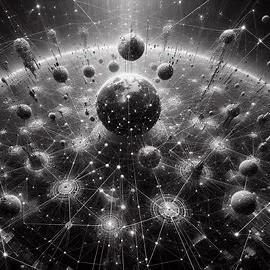EduardoLuft on Nostr: THE DIALECTICS OF NOSTR A summary of the dialectical ontology underlying this small ...
THE DIALECTICS OF NOSTR
A summary of the dialectical ontology underlying this small yet significant essay by G. Brander: "Nature's many attempts to evolve a Nostr": https://newsletter.squishy.computer/p/natures-many-attempts-to-evolve-a.
It seems that @fiatjaf has found a new way to deal with the space of possibilities (logical space) in the evolutionary dispute between protocols. In other words, a new way to advance through what I call Leibniz's quadrants¹ and perhaps gain a few good steps ahead of the competition.
Let's see.
Three Movements in Protocol Evolution
1. First Movement: Centralization
Everything begins with the tendency towards a certain (sometimes great) degree of centralization inherent in the formation process of these complex natural networks in which we are immersed. Networks of atoms (molecules), networks of organic molecules (living beings), network of living beings (ecosystems), network of people (societies) - and also networks of information processing and distribution tools: the vast internet, our topic at hand.
1.1. Maximum Centralization
(In the logical-dialectical space (read the post below), at the top of Parmenides' quadrant, maximum predominance of the One over the Many: +O/-M (stage 1))
Advantages (and the major disadvantage) of centralization: stability (at least initially), order, concentration of power (massive control of cryptographic keys and user data) and money to generate more power and money and grow further, while at the same time each new degree of centralization implies one more degree in increasing the risk of systemic collapse (the collapse of a single network node, in this case the central node, is enough for everything to come crashing down), that is, an increase in the fragility of the system.
Examples of Centralized Control:
a) Dictatorship;
b) Facebook.

2. Second Movement: Decentralization
2.1 Initial Decentralization
A still mild version of decentralization: in logical space, still in Parmenides' quadrant (+O/-M (stage 2)), but almost entering Leibniz's quadrants (the inferior quadrants).
Decentralization provides more flexibility and resilience to shocks (random or intentional).
Examples:
a) Oligopoly;
b) Federation: email, Mastodon.

2.2 Enhanced Decentralization
Examples:
a) Anarchism (anomie);
b) P2P.

In its extreme forms, more of a concept than a reality, since structures of maximum decentralization or maximum predominance of the Many over the One (-O/+M) are inherently unstable. The maximum predominance of the Many and its characteristics (difference, variation, underdetermination) over the One and its characteristics (identity, invariance, determination) implies maximum disorder or chaos.
3. Mesotês
The dynamic equilibrium between centralization and decentralization (exploration of Leibniz's quadrants (+O/+M) in logical space)
This is the new possibility explored by Nostr, according to the aforementioned essay. User control of cryptographic keys (the decentralization aspect of Nostr), acceptance of some degree of centralization in servers (relays) which, on the other hand, are dynamic, not static central nodes², as their power is continuously challenged and limited by user autonomy (who can change relays at any time).

When I see this, I immediately wonder if there might be a similar response to the current impasses surrounding the centralization of political power in our countries. I believe there must be some answer, in some corner of the logical space, and someone will yet discover it, and we will have not only more sustainable long-term decentralization of power, but with it, we will all have a broader space of freedom.
¹ Brander references network theory. In another context, I demonstrated the fruitful relationship between network theory and dialectical ontology:
https://www.academia.edu/20228035/Dialectic_and_Network_Ontology_The_Concept_of_Reason_after_Hegel_2014_
² The problem (ontological and ethical) is not centralization, but extreme & static centralization (the crystallization of power in corporations or governments).
NOTE1: The images above are all created by AI (copilot) (the reader can check the images used by Brander himself in his aforementioned essay).
NOTE2: More about logical space in dialectics here:
👇
A summary of the dialectical ontology underlying this small yet significant essay by G. Brander: "Nature's many attempts to evolve a Nostr": https://newsletter.squishy.computer/p/natures-many-attempts-to-evolve-a.
It seems that @fiatjaf has found a new way to deal with the space of possibilities (logical space) in the evolutionary dispute between protocols. In other words, a new way to advance through what I call Leibniz's quadrants¹ and perhaps gain a few good steps ahead of the competition.
Let's see.
Three Movements in Protocol Evolution
1. First Movement: Centralization
Everything begins with the tendency towards a certain (sometimes great) degree of centralization inherent in the formation process of these complex natural networks in which we are immersed. Networks of atoms (molecules), networks of organic molecules (living beings), network of living beings (ecosystems), network of people (societies) - and also networks of information processing and distribution tools: the vast internet, our topic at hand.
1.1. Maximum Centralization
(In the logical-dialectical space (read the post below), at the top of Parmenides' quadrant, maximum predominance of the One over the Many: +O/-M (stage 1))
Advantages (and the major disadvantage) of centralization: stability (at least initially), order, concentration of power (massive control of cryptographic keys and user data) and money to generate more power and money and grow further, while at the same time each new degree of centralization implies one more degree in increasing the risk of systemic collapse (the collapse of a single network node, in this case the central node, is enough for everything to come crashing down), that is, an increase in the fragility of the system.
Examples of Centralized Control:
a) Dictatorship;
b) Facebook.

2. Second Movement: Decentralization
2.1 Initial Decentralization
A still mild version of decentralization: in logical space, still in Parmenides' quadrant (+O/-M (stage 2)), but almost entering Leibniz's quadrants (the inferior quadrants).
Decentralization provides more flexibility and resilience to shocks (random or intentional).
Examples:
a) Oligopoly;
b) Federation: email, Mastodon.

2.2 Enhanced Decentralization
Examples:
a) Anarchism (anomie);
b) P2P.

In its extreme forms, more of a concept than a reality, since structures of maximum decentralization or maximum predominance of the Many over the One (-O/+M) are inherently unstable. The maximum predominance of the Many and its characteristics (difference, variation, underdetermination) over the One and its characteristics (identity, invariance, determination) implies maximum disorder or chaos.
3. Mesotês
The dynamic equilibrium between centralization and decentralization (exploration of Leibniz's quadrants (+O/+M) in logical space)
This is the new possibility explored by Nostr, according to the aforementioned essay. User control of cryptographic keys (the decentralization aspect of Nostr), acceptance of some degree of centralization in servers (relays) which, on the other hand, are dynamic, not static central nodes², as their power is continuously challenged and limited by user autonomy (who can change relays at any time).

When I see this, I immediately wonder if there might be a similar response to the current impasses surrounding the centralization of political power in our countries. I believe there must be some answer, in some corner of the logical space, and someone will yet discover it, and we will have not only more sustainable long-term decentralization of power, but with it, we will all have a broader space of freedom.
¹ Brander references network theory. In another context, I demonstrated the fruitful relationship between network theory and dialectical ontology:
https://www.academia.edu/20228035/Dialectic_and_Network_Ontology_The_Concept_of_Reason_after_Hegel_2014_
² The problem (ontological and ethical) is not centralization, but extreme & static centralization (the crystallization of power in corporations or governments).
NOTE1: The images above are all created by AI (copilot) (the reader can check the images used by Brander himself in his aforementioned essay).
NOTE2: More about logical space in dialectics here:
👇
quoting nevent1q…cvlfLOGICAL SPACE IN DIALECTICS
Dialectical ontology is a relational ontology: “only what is ‘in relation to’ remains determinate”, or what comes to the same, “only what is coherent remains determinate”. This is the very universal law inherent to all there is or can be, the objective reason that pervades every being.
All that happens and can happen occurs in or as a configuration. Configurations inserted in time or concrete configurations we call networks, configurations abstracted from time we call graphs (the privileged field of research of mathematics) (Barabási).
Existing is not precisely being, but being in the tense process of determination which aims at coherence, and when it does not achieve it falls apart or becomes lost in incoherence. Coherence is the immanent target, the attractor of the entire process of determination, but there are many, potentially infinite ways of carrying it out between the extremes of the maximum predominance of the One over the Many, or vice-versa.
While it occurs in the extreme face of the maximum predominance of the One (and its characteristic notes - identity, invariance and determination) over the Many, coherence is manifested as order, while when it occurs at the opposite face of the extreme predominance of the Many (and its notes - difference, variation and underdetermination) over the One, coherence is expressed as chaos.
Now let us perform an unusual thought experiment. Just imagine that you, Dear Reader, are located at an equal distance from the extremes of the maximum predominance of the One over the Many, and vice-versa, that is, in the company of that particular web of events that I call Leibniz’s Configuration (in the figure below, the point at the extreme lower part of the circumference (L)), and embarking on a trip in the direction of maximum order (if we look directly at the same figure, the movement that goes to the left beginning at the Leibniz’s Configuration), while a fellow adventurer follows the exactly opposite direction, aiming not at maximum order but at maximum chaos. During the course of the trip, you would be approaching the Parmenides’ Configuration (P), while your colleague, to his own despair - or not? - would be closer and closer to the Gorgias’ Configuration (G). Where would this trip end?
Apparently nowhere, or rather at a greater and greater distance between the two travelers. But this is not what in fact would occur. Let us come really close to the Gorgias’ Configuration and assess where this movement of approach would take us. Now, Gorgias’ Configuration, while it manifests itself as the maximum predominance of the Many over the One, does not have any stable determination except its own self-reference as a configuration, that is, at its extreme it reverts to the almost pure identity of the Parmenides’ Configuration.
On the other hand, the configuration which manifests itself at the opposite extreme, the Parmenides’ Configuration is apparently very stable in its pure self-reference, but, in fact, precisely in its almost full invariance, it is the most open to potential collapses and, therefore, the most unstable, because it is incompatible with any other of the infinite possible reconfigurations enabled by the universal law of coherence itself; in its extreme face, Parmenides’ Configuration reverts to the Gorgias’ Configuration.
Both the opposite manifestations of coherence revert, at their extremes, one into the other and, in their continuous oscillation, coincide. Following their antagonistic travels, aiming at the extreme opposites of order and chaos, you and your friend would end up by meeting again in the Cusanus’ Configuration (C) (at the upper point of the circumference).
In this brief thought experiment, we delimited the map of the dynamic logical space, the field of all possible thoughts and all possible forms of existence.
⚡
This is an excerpt from E. Luft (2017): https://www.academia.edu/35277761/Plato_or_Platonism_A_topic_in_descending_dialectic_2017_
⚡
nevent1q…67ay
